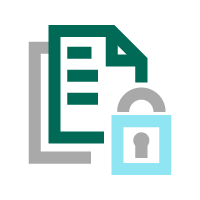Supporting NYDFS Compliance
Fortra's Data Classification solutions provide application of metadata and visual markings to Non-Public Information (NPI), allowing downstream processes and solutions the ability to apply controls and characteristics as stipulated in 23 NYCRR 500. NPI is defined in 23 NYCRR 500, Section 500.01(g).
Fortra's visual markings and metadata labels provide:
Utilize Data Classification To Assist In 23 NYCRR 500 Compliancy
The New York Department of Financial Services (NYDFS) began the enforcement of a new set of cybersecurity regulations for the banking, insurance, and financial sectors operating within the state of New York. The regulations were designed to encourage the development of durable processes and procedures necessary to protect customer data and underlying information technology systems. 23 NYCRR 500 went into effect on March 1, 2017 and specifically applies to "covered entities," those defined as “any Person operating under or required to operate under a license, registration, charter, certificate, permit, accreditation or similar authorization under the Banking Law, the Insurance Law or the Financial Services Law.” For those organizations attempting to verify their supervision under 23 NYCRR 500, NYDFS has provided a search form and the key dates associated with each milestone. Numerous cybersecurity regulations are intended, and ultimately designed, to achieve the same result – effective security throughout the data life cycle.
Data classification is a cornerstone capability in any mature data governance program that not only support compliance efforts but also provides the degree of transparency necessary for effective management. Recognizing the need for a solid data governance foundation, NYDFS codified data classification into the new regulation. Section 500.03 of 23 NYCRR 500 calls for the covered entity (typically the CISO) to create and maintain a Cybersecurity Policy with associated procedures “for the protection of its Information Systems and Nonpublic Information stored on those Information Systems”. Specifically, Section 500.03 (b) calls for "data governance and classification" to be included on those policy areas approved by a Senior Officer or the Covered Entity’s board of director s (or an appropriate committee thereof) or equivalent governing body.
The key tasks organizations must complete to comply with 23 NYCRR 500 include:
- Appointment a CISO (if one isn’t already in place)
- Perform risk assessments (which must be kept up to date on an ongoing basis)
- Document all organizational policies and procedures
- Perform penetration testing and vulnerability assessments
- Train all staff on a regular basis
- Monitor your assets and create audit trails
- Limit user privilege
- Securely destroy unnecessary data
Supporting Organizations In Implementing Data Classification
A key area the regulation looks to cover is the implementation of cybersecurity leadership through organizations by designating a qualified individual to serve as the CISO. This elected individual will be tasked with overseeing and enforcing the firm’s cybersecurity program and policy. Each organization will also need to implement regular staff training to cover specific cybersecurity risk areas. The stipulations of the new regulation make sure organizations have detection, defense and response capabilities, including regulatory reporting as well as penetration testing.
Just like other existing regulations, such as the European General Data Protection Regulation (GDPR), organizations must report any cyber security incidents to the DFS as promptly as possible (no later than 72 hours post incident). So how do organizations ensure they are compliant with 23 NYCRR 500? Evaluating the cybersecurity changes that may be required within the organization with the senior management team, including the CISO and board of directors, is a good place to start.
Key Components Necessary To Achieve And Maintain 23 NYCRR 500 Compliancy

"Great product
for user awareness"
Very good customer support for implementation and operations. The product is great for improving user awareness of data classification.
"Great Customer Satisfaction and a well integrated product"
The Fortra's Classifier Suite Engineers are very supportive in assisting with deployments, queries and handling issues.
"Helps to easily understand and implement classification"
Implementation is rather easier than other competitive products, administration console is also easier to understand and everything relevant to classification is there.
Why choose Fortra's Data Classification
With unrivalled customer service and best-of-breed data protection and governance solutions, we are helping many of the world’s most successful organizations take control of their business data. Everyday, our customers enjoy more effective, secure, and streamlined operations protecting their business critical information and reducing risk.
5 Steps to Effective Data Protection
DOWNLOAD GUIDE
If you're ready for a demo, let's talk about how we can help with your specific compliance needs.











